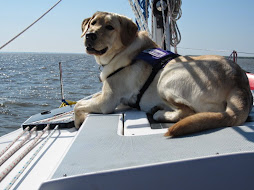Guest blog post by
Gail Frassetta, puppy raiser
And just like that, she’s off! SSD Hermione entered advanced
training, and I couldn’t be more proud of her. The journey with her has been
one of the most rewarding and happy experiences for not only me, but my entire
family.
We made the decision as a family to raise a service dog last
June and in a matter of a few weeks, we had Hermione in our home! I must say, I
was very impressed with what she already knew and was accustomed to. The
whelpers (the family that took care of the litter of puppies until they were
eight weeks old) did an amazing job of introducing sights, sounds, textures,
and experiences to these tiny pups. The puppy manual provided by Susquehanna
Service Dogs (SSD) also helped us prepare to have her in our home and to start
working with her until our training classes began.
SSD’s trainers guided us through each semester of training,
building on and perfecting what we learned in the previous semester. But we
didn’t just spend time in the classroom. As a matter of fact, as the puppies
get older, some of the classes are public outings. You can’t imagine what it
looks like to see 30-60 service dogs in training at Chocolate World, or walking
through the streets of Gettysburg, or even at the airport! These experiences
set up real life situations for the dogs to practice everything they learned in
the classroom and to gain skills and experiences necessary for a good service
dog.
But we didn’t stop with the experiences provided by SSD. We
had to get creative to think up situations and experiences for Hermione. She
learned how to be gentle with older humans and tiny humans. She learned to
quietly lay under a table at a restaurant on Thanksgiving. She visited schools
with hundreds of students who wanted to pet her.
Every one of these experiences helped Hermione become the
dog she is today. Each experience did not go perfectly but each was a chance
for her and me to learn.
As I met people throughout the year and talked with them
about the great work SSD does, so many people said, “I couldn’t do that. I just
couldn’t give the puppy up after raising them for over a year.” I felt from the
very beginning that I would be so proud to raise a puppy that could positively
impact someone’s life.
My resolve was solidified when I had the opportunity to
visit team training. Team training is a two and a half week period where the
service dogs begin to work with the person they were matched with. I sat with a
young girl who was so excited to have a dog that was trained to crawl under her
legs and stand up to raise her legs above her head if she fainted.
To see these dogs and people bonding and working together
confirmed for me that raising a service dog would be a rewarding experience.
And it has been!
P.S. I’m ready to raise another puppy!
If you would like to become a puppy raiser like Gail, you can apply online.
















































